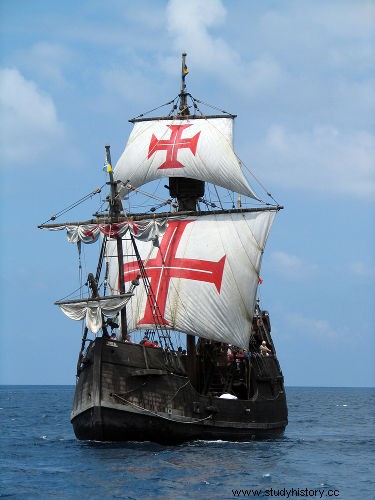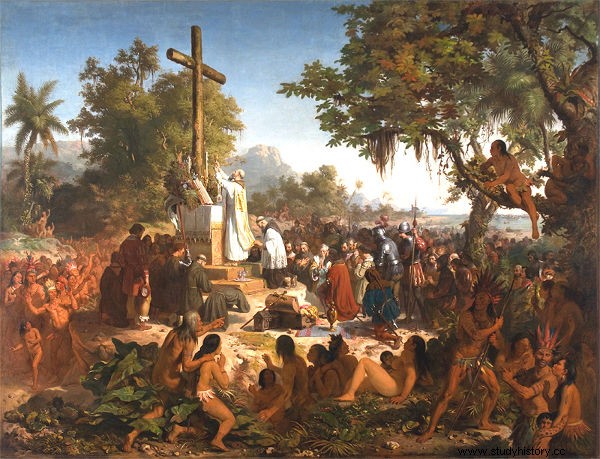The day April 22, 1500 was marked in Brazilian history as the date of the arrival of the Portuguese in Brazil. This event is also called by some “discovery from Brazil ”, and the Portuguese expedition, initially formed with 13 vessels, was led by the captain-major Pedro Álvares Cabral .
The Portuguese expedition and the news of the finding of Brazil were reported by the expedition's scribe, Pero Vaz de Caminha. The Portuguese remained in Brazilian lands until May 2, 1500, when they continued their journey towards India, the great objective of the expedition.
Login also :Hans Staden, the German who was a prisoner of the Tupinambás in the 16th century
Portuguese pioneering

The arrival of the Portuguese in Brazil is one of the final results of the great navigations , the oceanic exploration that took place throughout the 15th century. Although the Spaniards arrived in the American continent first, the Portuguese are considered the pioneers in this exploration process, making great “discoveries” in this period.
The pioneering role of the Portuguese has been studied by historians and justified on the basis of political, economic and geographical factors. First highlight refers to stability policy and the fact that Portugal had a territory unified for centuries. In the territorial case, the Portuguese had expelled the Moors, in 1249. By comparison, Spain, for example, fought the Moors until 1492, and the English and French fought each other in the Hundred Years' War until 1453.
In addition to having a consolidated territory, Portugal enjoyed a stable and conflict-free policy since the Avis dynasty began, at the end of the 14th century, when João , Avis master was crowned king of Portugal. Political stability and the unified territory allowed the country to enjoy a development commercial and technological .
This technological development ensured improvements in maritime navigation crucial for the Portuguese to explore the oceans. This exploration encompassed the interests of expansion commercial , military and religious of the Portuguese. In terms of trade, the Portuguese had a very important commercial center in Lisbon.
Interest in exotic goods such as spices (black pepper and cinnamon, for example), was what most moved the Portuguese in this context. India had a vast market for them, motivating them to maintain business contacts with her. As the traditional route, passing through Constantinople, had been closed, it was necessary to explore the ocean to find a new passage.
For this, Portugal decided to explore the coast of the African continent in search of a passage that would lead to India. These expeditions took us to places like Madeira , Azores and Cape Verde . They also installed trading posts, that is, trading posts, along the African coast. The desire for expansion is also due to the fact that the Portuguese, as Christians, sought to expand their domains as a way of promoting Christianization.
Europeans arrive in America
In this context of Atlantic exploration, the Spaniards decided to invest in an explorer who was determined to reach India by sailing west. This was Christopher Columbus , a Genoese who had been rejected by the Portuguese. With Spanish funding, he led three vessels that accidentally arrived on the American continent, on October 12, 1492.
With the news of the finding of a new land to the west, Portuguese and Spanish started a diplomatic dispute for control of the new lands that could be found. This dispute led to the writing of a papal bull in 1493 known as the bulla Inter Caetera , which delimited the division of the new lands between the two countries.
The Portuguese, not satisfied with the result of this bull, started new negotiations with the Spaniards, and the result was the signing of the Treaty of Tordesillas , in 1494. This treaty determined the passage of an imaginary line 370 leagues from the Cape Verde archipelago. The lands to the west (left) would be Spanish, and the lands to the east (right) would be Portuguese.
Read more :Hereditary captaincies – the first administrative measure implemented by the Portuguese
Arrival in Brazil

The signing of the Treaty of Tordesillas was therefore a milestone that reinforces the idea that the Portuguese knew that lands to the west could exist, they just hadn't reached them yet. After the African continent was bypassed, they were able to maintain commercial contact with India. It was in this context that the expedition of Pedro Álvares Cabral was organized . The Portuguese wanted to explore the possibilities to the west, and then they would go to India to buy spices.
So, as we can see, the captain-major of the expedition was Cabral, and he was ahead of 13 vessels , being three caravels and 10 ships, which set sail from Lisbon on March 9, 1500. The expedition's route followed a not very common path, a demonstration that they would make a change in it, in order to explore the west before going to to India.
The expedition has entered the calm zone from the ocean between the 29th and 30th of March, staying there for about 10 days. She crossed the Equator Line on the 9th of April, and on the 21st of April, the first signs of land had been sighted:seaweed. The next day, April 22, birds were sighted in the morning, and in the evening, the Portuguese spotted Monte Easter .
The Portuguese did not disembark that day, and it was not until April 23 that Cabral allowed a boat, led by Nicolau Rabbit , was sent to earth. There was the first contact with the indigenous people, an event reported by Pero Vaz de Caminha . Some of the natives were brought before Cabral, and the account left by the clerk is interesting and demonstrates the cultural difference. Here's a snippet:
They showed them a brown parrot that the Captain brings with him:they immediately grabbed it with their hand and waved it towards the land, as if to say that they were there. . They showed them a ram:they ignored it; a chicken:they were almost afraid of it – they didn't want to touch it, only to take it, with great astonishment in their eyes.
He was fed:bread and boiled fish, confectionery, cakes, honey and figs. They didn't want to eat almost any of it. And if they tasted something, then they spit it out in disgust|1| .
On April 26th, Easter Day , religious celebration celebrated seven days after Easter. This was the first mass that took place in Brazilian territory and was conducted by Fr Henrique de Coimbra . Finally, the Portuguese expedition decided to sail towards India on May 2, 1500.

The arrival of the Portuguese here in 1500 did not mean that expressive measures of colonization were carried out. The Portuguese priority was still the spice market, and, until the 1530s, the Portuguese presence took place through small factories on the coast. These factories were places where pau-brasil was exploited.
Note
|1| CASTRO Silvio. Pero Vaz de Caminha's letter . Porto Alegre:L&PM Pocket, 2013. p. 91
Image credits
[1] Commons
